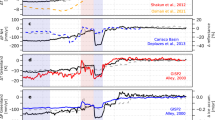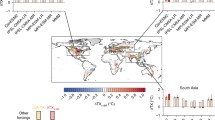Abstract
This paper is concerned with climate change in the region of the Canary Islands and the potential implications for the laurel forests of Tenerife. Frequent orographic cloud formation during the dry season is of vital importance to the altitudinal distribution of the laurel forests, because it maintains a semi-humid environment in the otherwise semi-arid climate of the Canary Islands. The distinctive environmental conditions in conjunction with the location of the Canary Islands on the Northern poleward edge of the Hadley Circulation make these ecosystems potentially highly sensitive to regional changes in climatic conditions. To explore this sensitivity, we first quantify observed trends in humidity and temperature across an altitudinal transect at the base of the Anaga peninsular, and second, analyse the results of three GCM experiments (CGCM1, ECHAM4 and CSIRO) to develop alternative climate change scenarios, and third, use these data to assess likely shifts in the elevational distribution of the laurel forest climate envelope. We report a significant increase in relative humidity and decreases in the diurnal temperature range on Tenerife at altitudes below the trade wind inversion within the last 30 years during the dry season, which suggests an increased occurrence of low-level clouds. There is also partial evidence for a drying trend across the trade wind inversion, which may be linked to an increased subsidence. Overall, the models suggest a downward shift of the area climatically suitable for laurel forests, which may be driven by changes in temperature and moisture supply in the region as well as by larger-scale changes in the atmospheric circulation. Our findings contrast with previously published findings for a tropical montane cloud region, which predict an upward shift of the cloud base. This suggests, following the assumptions inherent in the models applied, that the ecological consequences of climate change for cloud forests may be linked to their relative location in the Hadley Circulation.
Similar content being viewed by others
References
Ballacado, J. J.: 1976, ‘Notas Sobre la Distribucion y Evolucion de la Avifauna Canaria’, in Kunkel G. (ed.), Biogeography and Ecology of the Canary Islands, Junk Publisher, The Hague.
Bramwell, D.: 1972, ‘Endemism in the Flora of the Canary Islands’, in Valentine, D. H. (ed.), Taxonomy, Phytogeography and Evolution, Academic Press, London.
Bramwell, D.: 1976, ‘The Endemic Flora of the Canary Islands’, in Kunkel G. (ed.), Biogeography and Ecology of the Canary Islands, Junk Publisher, The Hague.
Bramwell, D.: 1990, ‘Conserving Biodiversity in the Canary Islands’, Ann. Missouri Botanical Garden 77(1), 29–37.
Bryan, K.: 1969, ‘Climate and the Ocean Circulation. Part III: The Ocean Model’, Mon. Wea. Rev. 97, 806–827.
Carlquist, S.: 1974, Island Biology, Columbia University Press, New York.
Cox, M. D.: 1984, ‘A Primitive Equation, Three-Dimensional Model of the Ocean’, GFDL Ocean Group Tech. Report. No. 1, GFDL, Princeton University, Princeton, NJ, p. 141.
de Nicholás, J. P., Nieto, E., Carbrera, P. G., Fernández-Palacios, J. M., and Ferrer, F. J.: 1989, ‘Variacion de la Correlación netre la Diverisidad y el Biovolumen de la Vegetacion sobre un Gradiente Altitudinal’, Studia Oecol. 1, 109–130.
Eguchi, T., Wildpret, W., de Arco, M., and Reyes-Betancort, A.: 1999, ‘Synoptic Analysis of Thermal and Moisture Conditions in Anaga, Tenerife, the Canary Islands’ in Ohsawa, M., Wildpret, W., and de Arco M. (eds.), Anaga Cloud Forest, Laboratory of Ecolocy, Chiba University, Japan, pp. 23–38.
Fernández-Palacios, J. M. and de Nicholás, J. P.: 1995, ‘Altitudinal Pattern of Vegetation Variation on Tenerife’, J. Veg. Sci. 6, 183–190.
Fernández-Palacios, J. M. and Arévalo, J. R.: 1998, ‘Regeneration Strategies of Tree Species in the Laurel Forest of Tenerife (the Canary Islands)’, Plant Ecol. 137, 21–29.
Fernández-Palacios, J. M. and Martín Esquivel, J. L.: 2001, Naturaleza de las Island Canarias: Ecología y Conservación, Publicaciones Turquesa S. L., Santa Cruz de Tenerife.
Fernandopulle, D.: 1976, ‘Climatic Characteristics of the Canary Islands’, in Kunkel, G. (ed.), Biogeography and Ecology of the Canary Islands, Junk Publisher, The Hague, pp. 185–207.
Flato, G. M., Boer, G. J., Lee, W. G., McFarlane, N. A., Ramsden, D., Reader, M. C., and Weaver, A. J.: 2000, ‘The Canadian Centre for Climate Modelling and Analysis Global Coupled Model and its Climate’, Clim. Dyn. 16, 451–467.
Gordon, H. B. and O'Farell, S. P.: 1997, ‘Transient Climate Change in the CSIRO Coupled Model with Dynamic Sea Ice’, Mon. Wea. Rev. 125, 875–907.
Hastenrath, S.: 1991, ‘Climate Dynamics of the Tropics’, Kluwer Academic Publishers, Dordrecht, The Netherlands.
Höllermann, P.: 1978, ‘Geoecological Aspects of the Upper Timberline in Tenerife, Canary Islands’, Arct. Alp. Res. 10, 365–382.
Höllermann, P.: 1981, ‘Microenvironmental Studies in the Laurel Forests of the Canary Islands’, Mount. Res. Dev. 1, 193–207.
Huetz de Lemps, A.: 1969, Le climate des Iles Canaries, Faculté des Lettres et des Sciences Humaines de Paris-Sorbonne, Paris.
Intergovernmental Panel on Climate Change (IPCC): 1990, in Houghton, J. T., Jenkins, G. J., and Ephraums, J. J. (eds.), Climate Change. The IPCC Scientific Assessment, Cambridge University Press, Cambridge.
Intergovernmental Panel on Climate Change (IPCC): 1992, in Houghton, J. T., Callander, B. A., and Varney, S. K. (eds.), Climate Change 1992, The Supplementary Report to the IPCC Scientific Assessment, Cambridge University Press, Cambridge.
Intergovernmental Panel on Climate Change (IPCC): 1996a, in Houghton, J. T., Meira Filho, L. G., Callander, B. A., Harris, N., Kattenberg, A., and Maskell, K., Climate Change 1995. The Science of Climate Change, Cambridge University Press, Cambridge.
Intergovernmental Panel on Climate Change (IPCC): 2001, in Houghton et al. (eds.), Climate Change 2001: The Scientific Basis, Technical Summary of the Working Group I Report, Cambridge University Press, Cambridge.
Jacobson, M. Z.: 1999, Fundamentals of Atmospheric Modelling, Cambridge University Press, Cambridge, England.
Kämmer F.: 1974, ‘Klima und Vegetation auf Tenerife besonders im Hinblick auf den Nebelniederschlag’, Scripta Geobot. 7, p. 78.
Lawton, R. O., Nair, U. S., Pielke, R. A., and Welch, R. M.: 2001: ‘Climatic Impact of Lowland Deforestation on nearby Montane Cloud Forests’, Science 294, 584–587.
Leggett, J., Pepper, W. J., and Swart, R. J.: 1992, ‘Emission Scenarios for the IPCC: An Update’, in Houghton, J. T., Callander, B. A., and Varney, S. K. (eds.), Climate Change 1992, The Supplementary Report to the IPCC Scientific Assessment, Cambridge University Press, Cambridge.
López-Gómez, J. and López-Gómez, A.: 1979, ‘El Clima de Canarias Según la Classificación de Köppen’, Estudios Geográficos 40, C.S.I.C., Madrid.
Machado, A.: 1976, ‘Introduction to a Faunal Study of the Canary Islands' Laurisilva, with Special Reference to the Ground Beetles’, in Kunkel, G. (ed.), Biogeography and Ecology of the Canary Islands, Junk Publisher, The Hague.
McFarlane, N. A., Boer, G. J., Blanchet, J-P., and Lazare, M.: 1992, ‘The Canadian Climate Centre Second-Generation General Circulation Model and its Equilibrium Climate’, J. Climate 5(10), 1013–1044.
McGuffie, K. and Henderson-Sellers, A.: 1997, ‘A Climate Modelling Primer’, 2nd edition, Wiley and Sons, Chichester.
Melville, R.: 1979, ‘Endangered Island Floras’, in Bramwell. D. (ed.), Plants and Islands, Academic Press, London, pp. 361–377.
Morales, D., Jiménez, M. S., González-Rodríguez, A. M., and Cermák, J.: 1996, ‘Laurel Forests in Tenerife, Canary Island’, Trees 11, 34–40.
Oberhuber, J. M.: 1993, ‘Simulation of the Atlantic Circulation with a Coupled Sea Ice-Mixed Layer-Isopycnal General Circulation Model. Part I: Model Description’, J. Phys. Oceanogr. 22, 808–829.
Ohsawa, M., Shumiya, T., Nitta, I., Wildpret, W., Del Arco, M., and Reyes-Betancort, A.: 1999, ‘Structure and Differentiation of Cloud Forests along Topographical Gradients in Anaga Mountains, Tenerife, the Canary Islands’, in Ohsawa, M., Wildpret, W., and Del Arco, M. (eds.), Ananga Cloud Forest. A Comparative Study on the Evergreen Broad-leaved Forest and Trees in the Canary Islands and Japan, Laboratory of Ecology, Chiba University, Chiba, Japan, pp. 67–87.
Parry, M. and Carter, T.: 1998, Climate Impact and Adaptation Assessment, Earthscan Publications, London, p. 166.
Pounds, J. A., Fodgen, M. P. L., and Campbell, J. H.: 1999. ‘Biological Response to Climatic Change on a Tropical Mountain’, Nature 398, 411–415.
Roeckner, E., Arpe, K., Bengtsson, L., Christoph, M., Claussen, M., Dümenil, L., Esch, M., Giorgetta, M., Schlese, U., and Schulzwida, U.: 1996, The Atmospheric General Circulation Model ECHAM-4: Model Discription and Simulation of Present Day Climate, Report No. 218, Max Planck-Institute für Meteorologie, Hamburg, Germany, p. 90.
Still, C. J., Foster, P. N., and Schneider, S. H.: 1999, ‘Simulating the Effects of Climate Change on Tropical Montane Cloud Forests’, Nature 398, 608–610.
Thompson, S. L. and Pollard, D.: 1997, ‘Greenland and Antarctic Mass Balances for Present and Doubled CO2 from the Genesis Version-2 Global Climate Model’, J. Climate 10, 871–900.
Voggenreiter, V.: 1974, ‘Geobotanische Untersuchungen and der natürlichen Vegetation der Kanareninsel Tenerife als Grundlage für den Naturschutz’, Dissertat. Botanicae 26, Cramer Verlag, Lehre, p. 718.
Author information
Authors and Affiliations
Corresponding author
Rights and permissions
About this article
Cite this article
Sperling, F.N., Washington, R. & Whittaker, R.J. Future Climate Change of the Subtropical North Atlantic: Implications for the Cloud Forests of Tenerife. Climatic Change 65, 103–123 (2004). https://doi.org/10.1023/B:CLIM.0000037488.33377.bf
Issue Date:
DOI: https://doi.org/10.1023/B:CLIM.0000037488.33377.bf




